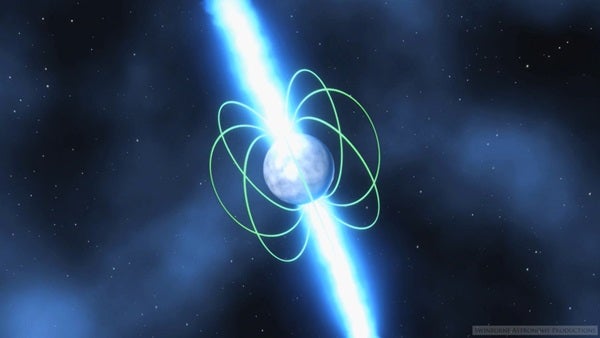“For pulsars, we have been able to use principles of nuclear physics, rather than gravity, to work out what their mass is, an exciting breakthrough which has the potential to revolutionize the way we make this kind of calculation,” said Wynn Ho of the University of Southampton.
“All previous precise measurements of pulsar masses have been made for stars that orbit another object, using the same techniques that were used to measure the mass of Earth or the Moon or discover the first extrasolar planets. Our technique is very different and can be used for pulsars in isolation,” said Cristobal Espinoza of the Pontificia Universidad Catolica de Chile.
Pulsars emit a rotating beam of electromagnetic radiation, which can be detected by telescopes when the beam sweeps past Earth, like observing the beam of a lighthouse. They are renowned for their incredibly stable rate of rotation, but young pulsars occasionally experience so-called glitches, where they are found to speed up for a brief period of time.
The prevailing theory is that these glitches arise as a rapidly spinning superfluid within the star transfers its rotational energy to the star’s crust, the component that is tracked by observations.
“Imagine the pulsar as a bowl of soup, with the bowl spinning at one speed and the soup spinning faster. Friction between the inside of the bowl and its contents, the soup, will cause the bowl to speed up. The more soup there is, the faster the bowl will be made to rotate,” said Nils Andersson from Southampton.
Ho has collaborated with Andersson and Espinoza and Danai Antonopoulou of the University of Amsterdam to use new radio and X-ray data to develop a novel mathematical model that can be used to measure the mass of pulsars that glitch. The idea relies on a detailed understanding of superfluidity. The magnitude and frequency of the pulsar glitches depend on the amount of superfluid in the star and the mobility of the superfluid vortices within. By combining observational information with the involved nuclear physics, one can determine the mass of the star.
The team’s results have important implications for the next generation of radio telescopes being developed by large international collaborations, like the Square Kilometer Array and the Low Frequency Array, of which Southampton is a UK partner university. The discovery and monitoring of many more pulsars is one of the key scientific goals of these projects.
“Our results provide an exciting new link between the study of distant astronomical objects and laboratory work in both high-energy and low-temperature physics. It is a great example of interdisciplinary science,” said Andersson.










